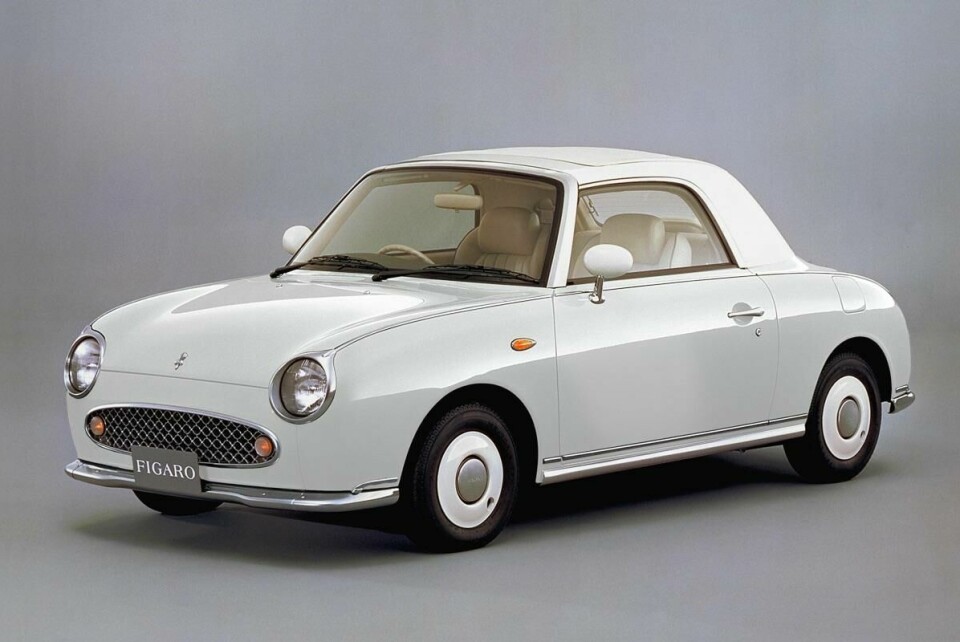
Nissan S-Cargo (1988)
Remembering the Pike Factory cars that started the retro design trend
In the 1980s Japan’s economy and its design community were riding high. Times were good, and Japan responded with innovative works in industrial design, electronics, architecture, and automotive design.
Looking over its domestic automotive market, Nissan saw the popularity of personal electronics such as cameras, and portable music players, decided to explore the idea of a car as lifestyle object and fashion accessory.
At the 1987 Tokyo Motor Show, Nissan introduced three concepts, and one, the Be-1 went into limited production, and only for the Japanese home market. It was sold at Nissan Cherry stores – lifestyle brand stores that de-emphasized the Nissan origins and promoted the little cars as hip accessories to a young urban lifestyle.
The Be-1 would be followed by the Nissan S-Cargo, a tiny utility vehicle; The Pao, a sort of mini-Citroen Mehari; and the Figaro, a tiny sports car.
The cars were all produced at Nissan’s Aichi Machine Industry plant, dubbed the Pike Factory, and were hand assembled.

Sibling soft-top the Nissan Figaro
Years later, writing about the Pike Factory cars, our colleague, the late Phil Patton, noted:
“The Pike cars represented the height of postmodernism. Unabashedly retro, they were inspired by French and Italian designs of the ’50s, promiscuously combining elements of the Citroën 2CV, Renault 4, Mini, Fiat 500 and even the East German Trabant into an archetypal car.
Each type of Pike car was produced in limited numbers, essentially as fashion accessories for hip young Japanese… Nissan did not heavily promote the cars — customers had to discover them, like an unmarked club — (and) they exceeded expectations. The company held lotteries for the right to buy one.”

The S-Cargo, three ways
The S-Cargo was an unusual choice for its limited production. But the Pike vehicles were sort of anti-cars, and a utility-van-as-fashion-accessory proved very popular. The design of the S-Cargo was an homage to the Citroen 2CV Fourgonnette. The name was a very thinly disguised double entendre. Officially, the name was Small Cargo, or S-Cargo. Of course, S-Cargo sounds like the French word for snail, escargot, which is also a nickname for the Citroen 2CV.
The whole design was a composition of circles animating what would otherwise be a boxy form. The hood arches over the engine, and the roof is a great vault that starts at the windscreen and arches over the cargo area, and then is truncated at the nearly vertical rear hatch. The sides of the S-Cargo are vertical with no surface modeling. The quarter-circle windows at the doors and the (optional) oval portholes in the cargo area helped graphically animate what was an already unique form. At the front, the bug-eyed headlights betray a bit of Austin-Healey Sprite floating around in the design gene pool.

The cool, minimal interior
In the interior, a simple bench seat awaits the driver and passenger. The IP is a designed as a flat surface with an “office desk feel” for the business on the go. There is a removable sushi tray to transform the S-Cargo into a lunchtime sushi bar. The controls are simple sliders and shifters. The instrumentation is minimal, with a semicircular speedometer that contained smaller circular gauges. The steering wheel is mounted on a single Citroen-like spoke.
The S-Cargo was built on a Nissan B-11 Station Sunny platform and shared its 1.4 litre petrol engine. It had a three-speed transmission and came equipped with air conditioning – unusual, given its large interior volume.

Bad boy designer Naoki Sakai
The designer of the Pike Cars was Naoki Sakai, a design school dropout who claimed to have made a fortune selling Japanese tattoo-themed T-Shirts in San Francisco in the early 1980s. After supposedly blowing his fortune he retreated to Japan and opened an industrial design office. He managed to secure work for a number of Japanese companies. His brushed aluminum design for the Olympus O-product is considered a classic, and like the S-Cargo, is a composition of circles animating a box-like form.

Sakai’s Olympus O-product camera
Sakai designed the entire line of Pike cars (although the design of Figaro has also been attributed to Shoji Takahashi), and later the Toyota Will series, as well as a host of other products for Japanese manufacturers. He maintains his own design practice, Water Design, and has a reputation as an outspoken and outrageous designer and critic (here’s a rather excellent interview with him).
The Pike factory cars can still be seen on occasion in Japan and also in the UK, to where quite a few Figaros were imported, initially making their way into the hands of celebrities (Eric Clapton owned one), then less well-off collectors and admirers of the little car’s cheeky charm.

Again like the 2CV, the roof rolled back
The legacy of the cars soon outshone the originals, as the retro theme spread throughout the automotive world in the 1990s. The Volkswagen New Beetle, Fiat 500, BMW Mini, Chrysler PT Cruiser, Plymouth Prowler, new Ford Thunderbird and many others owe their retro roots to the Pike cars.
The S-Cargo regularly appears near the top of “ugliest car of all time lists”, but the little car has a devoted following too. And in an era where we are debating the notion of a megacity car, an electric and perhaps autonomous version of the S-Cargo seems to make perfect sense – like a delivery truck version of the Google car. We just hope the on-board sushi bar is retained as a standard feature…



